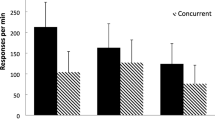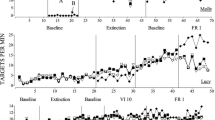Abstract
Three human subjects responded for food reinforcers by pulling on either of two doors of a modified vending machine. Participants were exposed to three conditions, each of which contained a different pair of concurrent variable-interval variable-interval schedules and a changeover delay. All subjects matched both responses and time spent responding to the distribution of reinforcers associated with the schedules. These results confirm the applicability of the matching law in describing human behavior in concurrent operant situations and extend the generality of the matching law to include consummatory behavior in humans.
Similar content being viewed by others
References
BAUM, W.M. 1975. Time allocation in human vigilance, Journal of the Experimental Analysis of Behavior, 23, 45–53.
BAUM, W.M., & RACHLIN, H.C. 1969. Choice as time allocation. Journal of the Experimental Analysis of Behavior, 12, 861–874.
BRADSHAW, C. M., SZABADI, E., & BEVAN, P. 1976. Behavior of humans in variable-interval schedules of reinforcement. Journal of the Experimental Analysis of Behavior, 26, 135–141.
BRADSHAW, C. M., SZABADI, E., & BEVAN, P. 1979. The effect of punishment on free- operant choice behavior in humans. Journal of the Experimental Analysis of Behavior, 31, 71–81.
BRADSHAW, C.M., SZABADI, E., BEVAN, P., & RUDDLE, H.V. 1979. The effect of signaled reinforcement availability on concurrent performances in humans. Journal of the Experimental Analysis of Behavior, 32, 65–74.
BROWNSTEIN, A.J., & PLISKOFF, S.S. 1968. Some effects of relative reinforcement rate and changeover delay in response-independent concurrent schedules of reinforcement. Journal of the Experimental Analysis of Behavior, 11, 683–688.
BUSKIST, W.F., BENNETT, R.H., & MILLER, H.L. In press. Effects of instructional constraints on human fixed-interval performance. Journal of the Experimental Analysis of behavior.
DE VILLIERS, P.A. 1977. Choice in concurrent schedules and a quantitative formulation of the law of effect. In W.K. Honig & J.E.R. Staddon (Eds.). Handbook of operant behavior. Englewood, N.J.: Prentice Hall.
FINDLEY, J.D. 1958. Preference and switching under concurrent scheduling. Journal of the Experimen tal A n a lysis of Be ha vior, 1, 123–144.
HERRNSTEIN, R.J. 1961. Relative and absolute strength of response as a function of frequency of reinforcement. Journal of the Experimental Analysis of Behavior, 4, 267–272.
HERRNSTEIN, R.J. 1970. On the law of effect. Journal of the Experimental Analysis of Behavior, 13, 243–266.
HERRNSTEIN, R.J. 1974. Formal properties of the matching law. Journal of the Experimental Analysis of Behavior, 21, 159–164.
HERRNSTEIN, R.J. 1979. Derivatives of matching. Psychological Review, 86, 486–495.
MATTHEWS, B.A., SHIMOFF, E., CATANIA, A.C & SAGVOLDEN, T. 1977. Unin- structed human responding: sensitivity to ratio and interval contingencies. Journal of the Experimental Analysis of Behavior, 27, 453–467.
MCSWEENY, F.K. 1975. Matching and contrast on several concurrent treadle-press schedules. Journal of the Experimental Analysis of Behavior, 23, 193–198.
OSTLE, B., & MENSING, R.W. 1975. Statistics in research. Ames, Iowa: Iowa State University Press.
SCHMITT, D.R. 1974. Effects of reinforcement rate and reinforcer magnitude on choice behavior in humans. Journal of the Experimental Analysis of Behavior, 21, 409–419.
SCHROEDER, S.R., & HOLLAND, J.G. 1969. Reinforcement of eye movement with concurrent schedules. Journal of the Experimental Analysis of Behavior, 12, 897–903.
SHULL, R.L., & PLISKOFF, S.S. 1967. Changeover delay and concurrent schedules: some effects on relative performance measures. Journal of the Experimental Analysis of Behavior, 10, 517–527.
SILBERBERG, A., & FANTINO, E. 1970. Choice, rate of reinforcement, and the changeover delay. Journal of the Experimental A nalysis of Behavior, 13, 187–197.
Author information
Authors and Affiliations
Additional information
The research reported herein was supported by a Brigham Young University Faculty Research Grant to the second author.
Rights and permissions
About this article
Cite this article
Buskist, W.F., Miller, H.L. Concurrent Operant Performance in Humans: Matching When Food is the Reinforcer. Psychol Rec 31, 95–100 (1981). https://doi.org/10.1007/BF03394723
Published:
Issue Date:
DOI: https://doi.org/10.1007/BF03394723




